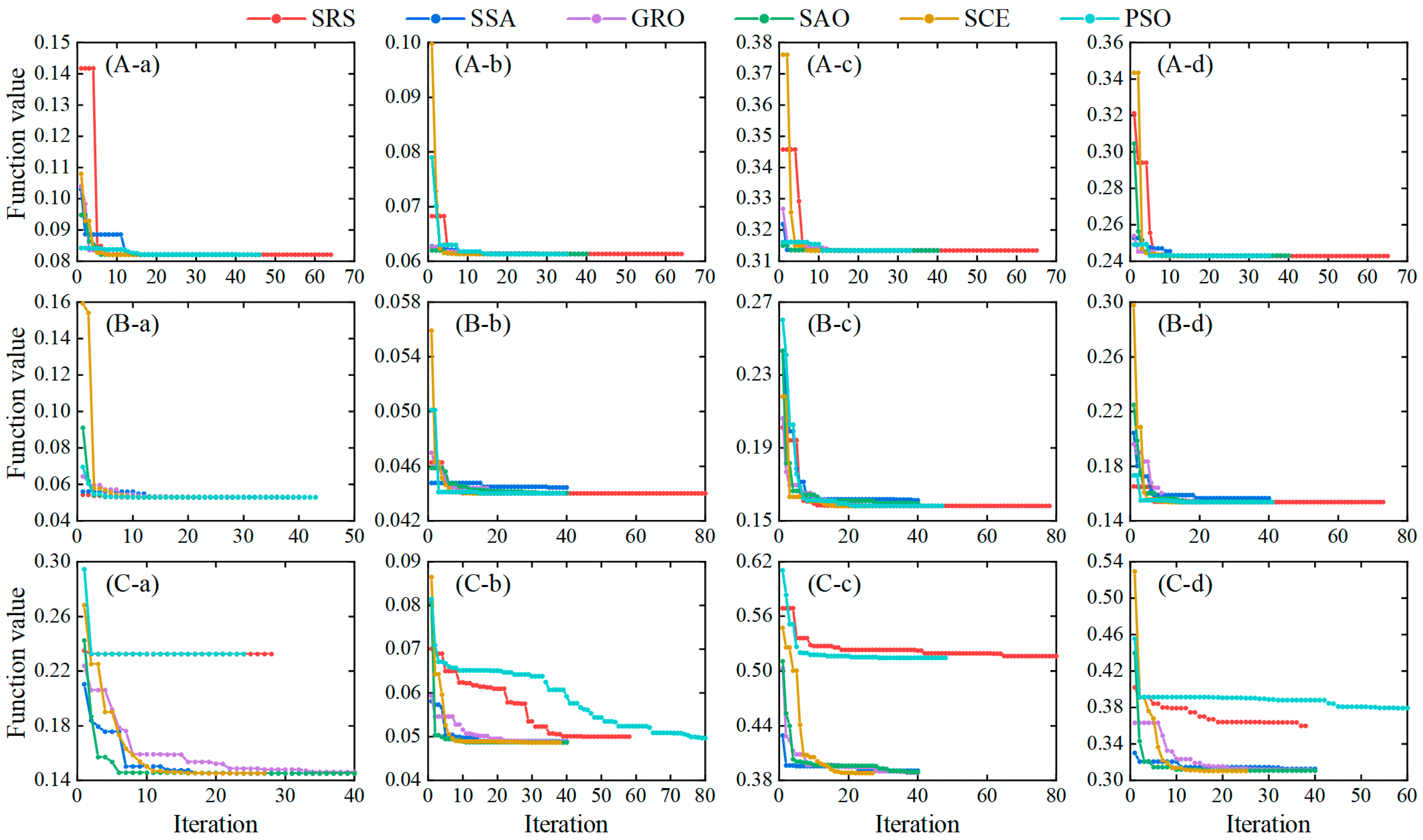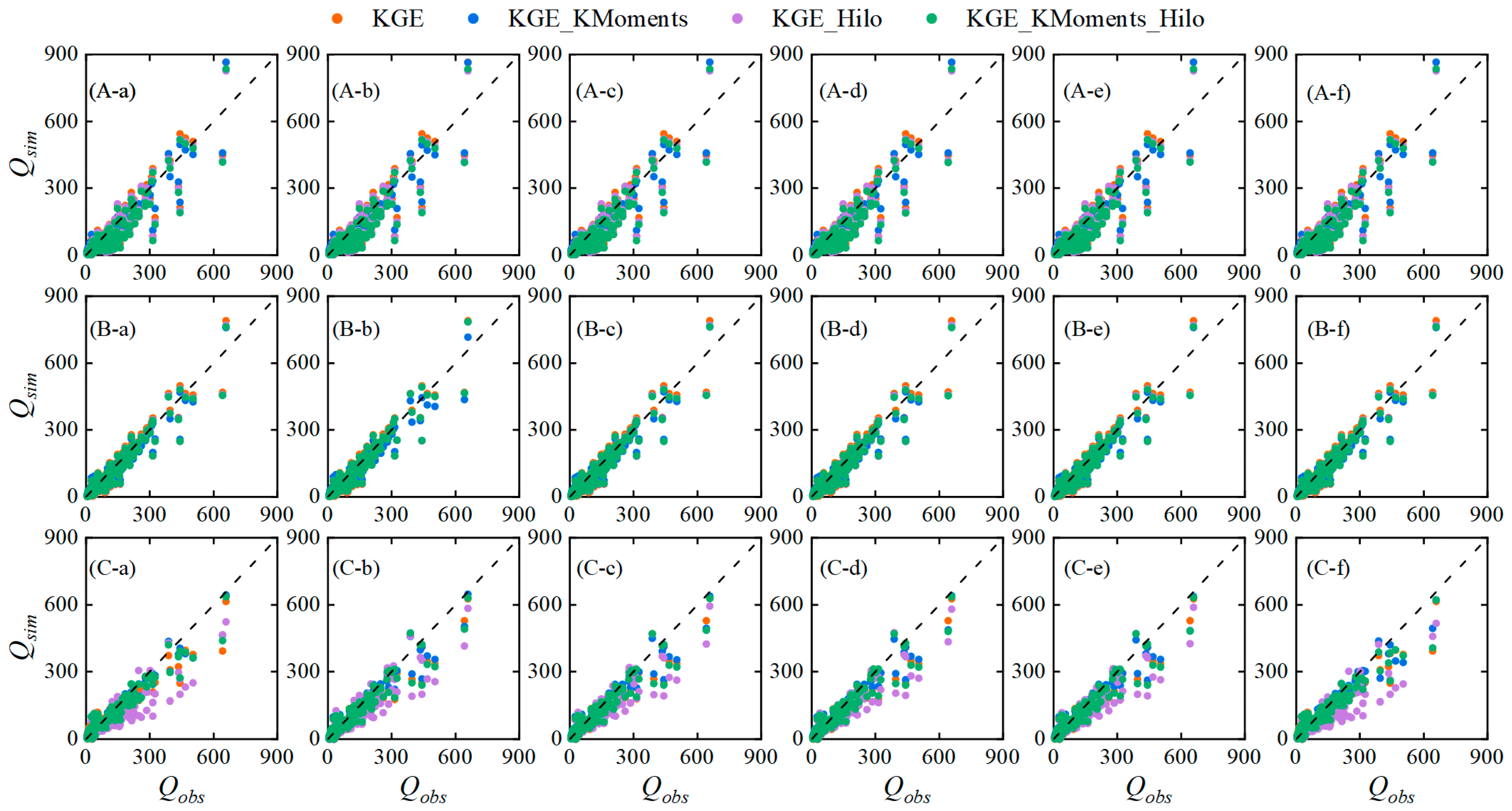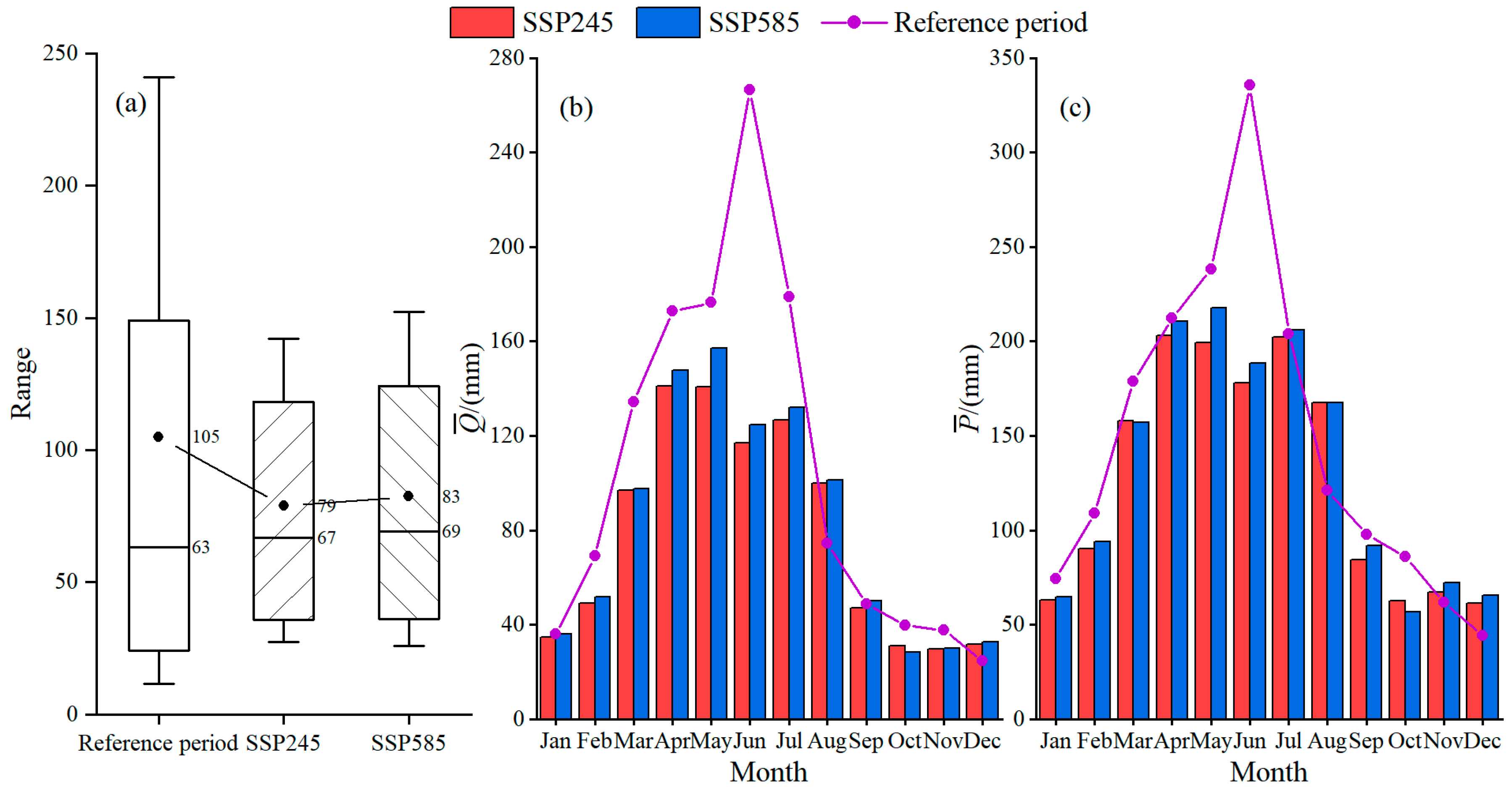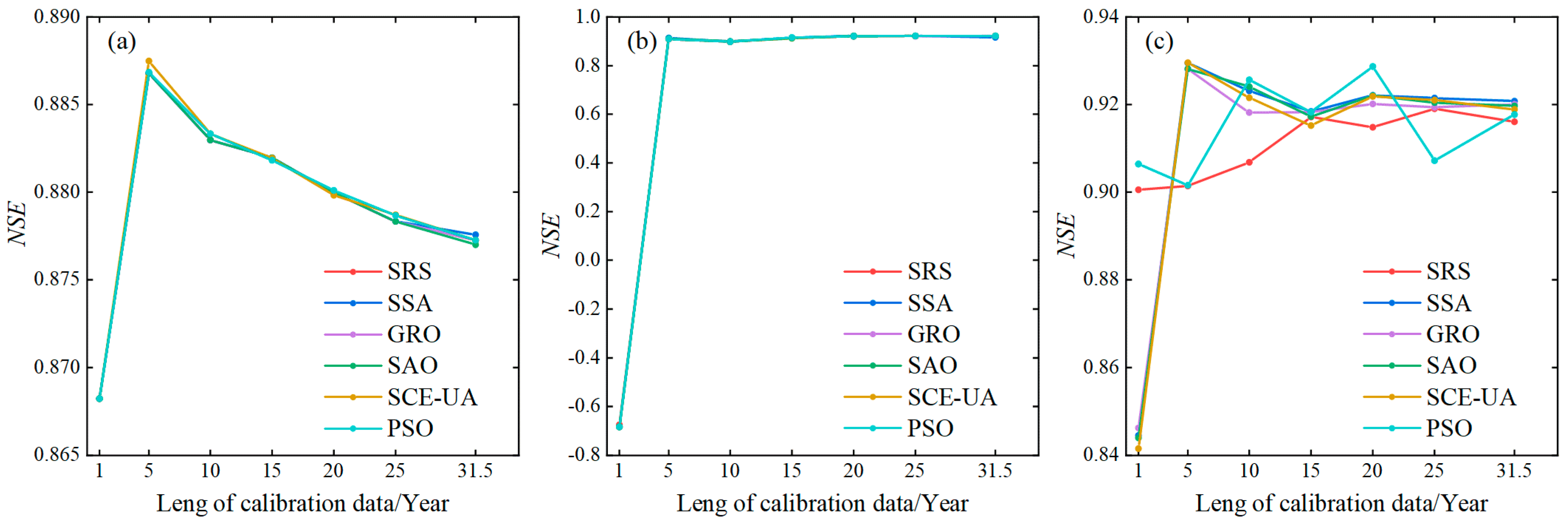Runoff Prediction of Tunxi Basin under Projected Climate Changes Based on Lumped Hydrological Models with Various Model Parameter Optimization Strategies
Abstract
1. Introduction
2. Study Area and Data Sources
2.1. Study Area
2.2. Hydrometeorological Data
2.3. GCM Data
3. Methodology
3.1. Hydrological Models
3.2. Model Parameter Calibration Scenarios
3.2.1. Optimization Algorithms
3.2.2. Objective Functions
3.3. Evaluation Metrics
4. Results and Discussion
4.1. Efficiency Analysis under Parameter Calibration Scenarios
4.2. Comparison of Runoff Modeling Efficiency and Stability
4.3. Runoff Prediction under Future Climate Projections
4.4. Discussion
5. Conclusions
Author Contributions
Funding
Institutional Review Board Statement
Informed Consent Statement
Data Availability Statement
Acknowledgments
Conflicts of Interest
References
- IPCC. Climate Change 2021: The Physical Science Basis, Summary for Policymakers; Cambridge University Press: Cambridge, UK, 2021. [Google Scholar]
- Pan, Z.; Liu, P.; Gao, S.; Xia, J.; Chen, J.; Cheng, L. Improving hydrological projection performance under contrasting climatic conditions using spatial coherence through a hierarchical Bayesian regression framework. Hydrol. Earth Syst. Sci. 2019, 23, 3405–3421. [Google Scholar] [CrossRef]
- Miao, C.; Gou, J.; Fu, B.; Tang, Q.; Duan, Q.; Chen, Z.; Lei, H.; Chen, J.; Guo, J.; Borthwick, A.G.L.; et al. High-quality reconstruction of China’s natural streamflow. Sci. Bull. 2022, 67, 547–556. [Google Scholar] [CrossRef] [PubMed]
- Wang, W.-c.; Cheng, Q.; Chau, K.-w.; Hu, H.; Zang, H.-f.; Xu, D.-m. An enhanced monthly runoff time series prediction using extreme learning machine optimized by salp swarm algorithm based on time varying filtering based empirical mode decomposition. J. Hydrol. 2023, 620, 129460. [Google Scholar] [CrossRef]
- Beck, H.E.; Vergopolan, N.; Pan, M.; Levizzani, V.; van Dijk, A.I.J.M.; Weedon, G.P.; Brocca, L.; Pappenberger, F.; Huffman, G.J.; Wood, E.F. Global-scale evaluation of 22 precipitation datasets using gauge observations and hydrological modeling. Hydrol. Earth Syst. Sci. 2017, 21, 6201–6217. [Google Scholar] [CrossRef]
- Zhang, J.; Wang, D.; Wang, Y.; Xiao, H.; Zeng, M. Runoff Prediction Under Extreme Precipitation and Corresponding Meteorological Conditions. Water Resour. Manag. 2023, 37, 3377–3394. [Google Scholar] [CrossRef]
- Refsgaard, J.C.; Stisen, S.; Koch, J. Hydrological process knowledge in catchment modelling—Lessons and perspectives from 60 years development. Hydrol. Process. 2022, 36, e14463. [Google Scholar] [CrossRef]
- Wu, H.; Zhang, J.; Bao, Z.; Wang, G.; Wang, W.; Yang, Y.; Wang, J. Runoff Modeling in Ungauged Catchments Using Machine Learning Algorithm-Based Model Parameters Regionalization Methodology. Engineering 2023, 28, 93–104. [Google Scholar] [CrossRef]
- Mai, J. Ten strategies towards successful calibration of environmental models. J. Hydrol. 2023, 620, 129414. [Google Scholar] [CrossRef]
- Zhang, Q.; Zhou, A.; Jin, Y. RM-MEDA: A Regularity Model-Based Multiobjective Estimation of Distribution Algorithm. IEEE Trans. Evol. Comput. 2008, 12, 41–63. [Google Scholar] [CrossRef]
- Konapala, G.; Mishra, A.K.; Wada, Y.; Mann, M.E. Climate change will affect global water availability through compounding changes in seasonal precipitation and evaporation. Nat. Commun. 2020, 11, 3044. [Google Scholar] [CrossRef]
- Wang, Q.; Sun, Y.; Guan, Q.; Du, Q.; Zhang, Z.; Zhang, J.; Zhang, E. Exploring future trends of precipitation and runoff in arid regions under different scenarios based on a bias-corrected CMIP6 model. J. Hydrol. 2024, 630, 130666. [Google Scholar] [CrossRef]
- Zhang, J.; Ma, S.; Song, Y. Hydrological and water quality simulation and future runoff prediction under CMIP6 scenario in the upstream basin of Miyun Reservoir. J. Water Clim. Chang. 2022, 13, 2505–2530. [Google Scholar] [CrossRef]
- Zhao, J.; He, S.; Wang, H. Historical and future runoff changes in the Yangtze River Basin from CMIP6 models constrained by a weighting strategy. Environ. Res. Lett. 2022, 17, 024015. [Google Scholar] [CrossRef]
- Lei, Y.; Chen, J.; Xiong, L. A comparison of CMIP5 and CMIP6 climate model projections for hydrological impacts in China. Hydrol. Res. 2023, 54, 330–347. [Google Scholar] [CrossRef]
- Vrugt, J.A.; Gupta, H.V.; Bouten, W.; Sorooshian, S. A Shuffled Complex Evolution Metropolis algorithm for optimization and uncertainty assessment of hydrologic model parameters. Water Resour. Res. 2003, 39, 1–14. [Google Scholar] [CrossRef]
- Zhang, X.; Srinivasan, R.; Zhao, K.; Liew, M.V. Evaluation of global optimization algorithms for parameter calibration of a computationally intensive hydrologic model. Hydrol. Process. 2009, 23, 430–441. [Google Scholar] [CrossRef]
- Wang, Y.; Brubaker, K. Multi-objective model auto-calibration and reduced parameterization: Exploiting gradient-based optimization tool for a hydrologic model. Environ. Model. Softw. 2015, 70, 1–15. [Google Scholar] [CrossRef]
- Yan, X.; Niu, B.; Chai, Y.; Zhang, Z.; Zhang, L. An adaptive hydrologic cycle optimization algorithm for numerical optimization and data clustering. Int. J. Intell. Syst. 2022, 37, 6123–6151. [Google Scholar] [CrossRef]
- Siddique, N.; Adeli, H. Nature Inspired Computing: An Overview and Some Future Directions. Cogn. Comput. 2015, 7, 706–714. [Google Scholar] [CrossRef]
- Sivakumar, B. Nonlinear dynamics and chaos in hydrologic systems: Latest developments and a look forward. Stoch. Environ. Res. Risk Assess. 2009, 23, 1027–1036. [Google Scholar] [CrossRef]
- Duan, Q.; Sorooshian, S.; Gupta, V. Effective and efficient global optimization for conceptual rainfall-runoff models. Water Resour. Res. 1992, 28, 1015–1031. [Google Scholar] [CrossRef]
- Eberhart, R.; Kennedy, J. A new optimizer using particle swarm theory. In Proceedings of the Sixth International Symposium on Micro Machine and Human Science (MHS’95), Nagoya, Japan, 4–6 October 1995; pp. 39–43. [Google Scholar]
- Yang, X.S.; Suash, D. Cuckoo Search via Lévy flights. In Proceedings of the 2009 World Congress on Nature & Biologically Inspired Computing (NaBIC), Coimbatore, India, 9–11 December 2009; pp. 210–214. [Google Scholar]
- Xue, J.; Shen, B. A novel swarm intelligence optimization approach: Sparrow search algorithm. Syst. Sci. Control Eng. 2020, 8, 22–34. [Google Scholar] [CrossRef]
- Wei, H.; Zhang, Y.; Liu, C.; Huang, Q.; Jia, P.; Xu, Z.; Guo, Y. The Strategic Random Search (SRS)—A new global optimizer for calibrating hydrological models. Environ. Model. Softw. 2024, 172, 105914. [Google Scholar] [CrossRef]
- Zolfi, K. Gold rush optimizer: A new population-based metaheuristic algorithm. Oper. Res. Decis. 2023, 33, 113–150. [Google Scholar] [CrossRef]
- Deng, L.; Liu, S. Snow ablation optimizer: A novel metaheuristic technique for numerical optimization and engineering design. Expert Syst. Appl. 2023, 225, 120069. [Google Scholar] [CrossRef]
- Hunter, J.; Thyer, M.; McInerney, D.; Kavetski, D. Achieving high-quality probabilistic predictions from hydrological models calibrated with a wide range of objective functions. J. Hydrol. 2021, 603, 126578. [Google Scholar] [CrossRef]
- Wan, Y.; Chen, J.; Xu, C.-Y.; Xie, P.; Qi, W.; Li, D.; Zhang, S. Performance dependence of multi-model combination methods on hydrological model calibration strategy and ensemble size. J. Hydrol. 2021, 603, 127065. [Google Scholar] [CrossRef]
- Confesor Jr, R.B.; Whittaker, G.W. Automatic Calibration of Hydrologic Models With Multi-Objective Evolutionary Algorithm and Pareto Optimization1. J. Am. Water Resour. Assoc. 2007, 43, 981–989. [Google Scholar] [CrossRef]
- Nash, J.E.; Sutcliffe, J.V. River flow forecasting through conceptual models part I—A discussion of principles. J. Hydrol. 1970, 10, 282–290. [Google Scholar] [CrossRef]
- Gupta, H.V.; Kling, H.; Yilmaz, K.K.; Martinez, G.F. Decomposition of the mean squared error and NSE performance criteria: Implications for improving hydrological modelling. J. Hydrol. 2009, 377, 80–91. [Google Scholar] [CrossRef]
- McInerney, D.; Thyer, M.; Kavetski, D.; Lerat, J.; Kuczera, G. Improving probabilistic prediction of daily streamflow by identifying Pareto optimal approaches for modeling heteroscedastic residual errors. Water Resour. Res. 2017, 53, 2199–2239. [Google Scholar] [CrossRef]
- Sahraei, S.; Asadzadeh, M.; Unduche, F. Signature-based multi-modelling and multi-objective calibration of hydrologic models: Application in flood forecasting for Canadian Prairies. J. Hydrol. 2020, 588, 125095. [Google Scholar] [CrossRef]
- Wu, Y.; Liu, S. A suggestion for computing objective function in model calibration. Ecol. Inform. 2014, 24, 107–111. [Google Scholar] [CrossRef]
- Althoff, D.; Rodrigues, L.N. Goodness-of-fit criteria for hydrological models: Model calibration and performance assessment. J. Hydrol. 2021, 600, 126674. [Google Scholar] [CrossRef]
- Cortés-Salazar, N.; Vásquez, N.; Mizukami, N.; Mendoza, P.A.; Vargas, X. To what extent does river routing matter in hydrological modeling? Hydrol. Earth Syst. Sci. 2023, 27, 3505–3524. [Google Scholar] [CrossRef]
- Zhang, Y.; Shao, Q.; Zhang, S.; Zhai, X.; She, D. Multi-metric calibration of hydrological model to capture overall flow regimes. J. Hydrol. 2016, 539, 525–538. [Google Scholar] [CrossRef]
- Koutsoyiannis, D. Knowable moments for high-order stochastic characterization and modelling of hydrological processes. Hydrol. Sci. J. 2019, 64, 19–33. [Google Scholar] [CrossRef]
- Pizarro, A.; Jorquera, J. Advancing objective functions in hydrological modelling: Integrating knowable moments for improved simulation accuracy. J. Hydrol. 2024, 634, 131071. [Google Scholar] [CrossRef]
- Arsenault, R.; Poulin, A.; Côté, P.; Brissette, F. Comparison of Stochastic Optimization Algorithms in Hydrological Model Calibration. J. Hydrol. Eng. 2014, 19, 1374–1384. [Google Scholar] [CrossRef]
- Monteil, C.; Zaoui, F.; Le Moine, N.; Hendrickx, F. Multi-objective calibration by combination of stochastic and gradient-like parameter generation rules—The caRamel algorithm. Hydrol. Earth Syst. Sci. 2020, 24, 3189–3209. [Google Scholar] [CrossRef]
- Gou, J.; Miao, C.; Duan, Q.; Tang, Q.; Di, Z.; Liao, W.; Wu, J.; Zhou, R. Sensitivity Analysis-Based Automatic Parameter Calibration of the VIC Model for Streamflow Simulations Over China. Water Resour. Res. 2020, 56, e2019WR025968. [Google Scholar] [CrossRef]
- Xiong, L.; Guo, S. A two-parameter monthly water balance model and its application. J. Hydrol. 1999, 216, 111–123. [Google Scholar] [CrossRef]
- Wang, W.; Li, C.; Xing, W.; Fu, J. Projecting the potential evapotranspiration by coupling different formulations and input data reliabilities: The possible uncertainty source for climate change impacts on hydrological regime. J. Hydrol. 2017, 555, 298–313. [Google Scholar] [CrossRef]
- Ávila, L.; Silveira, R.; Campos, A.; Rogiski, N.; Freitas, C.; Aver, C.; Fan, F. Seasonal Streamflow Forecast in the Tocantins River Basin, Brazil: An Evaluation of ECMWF-SEAS5 with Multiple Conceptual Hydrological Models. Water 2023, 15, 1695. [Google Scholar] [CrossRef]
- Jam-Jalloh, S.U.; Liu, J.; Wang, Y.; Li, Z.; Jabati, N.-M.S. Wavelet Analysis and the Information Cost Function Index for Selection of Calibration Events for Flood Simulation. Water 2023, 15, 2035. [Google Scholar] [CrossRef]
- Sun, J.; Yan, H.; Bao, Z.; Wang, G. Investigating Impacts of Climate Change on Runoff from the Qinhuai River by Using the SWAT Model and CMIP6 Scenarios. Water 2022, 14, 1778. [Google Scholar] [CrossRef]
- Zhou, J.; Lu, H.; Yang, K.; Jiang, R.; Yang, Y.; Wang, W.; Zhang, X. Projection of China’s future runoff based on the CMIP6 mid-high warming scenarios. Sci. China Earth Sci. 2023, 66, 528–546. [Google Scholar] [CrossRef]
- Peng, S.; Ding, Y.; Liu, W.; Li, Z. 1 km monthly temperature and precipitation dataset for China from 1901 to 2017. Earth Syst. Sci. Data 2019, 11, 1931–1946. [Google Scholar] [CrossRef]
- Peng, S. 1-km Monthly Precipitation Dataset for CHINA (1901–2022); National Tibetan Plateau/Third Pole Environment Data Center: Beijing, China, 2020. [Google Scholar] [CrossRef]
- Peng, S. 1 km Monthly Potential Evapotranspiration Dataset in CHINA (1901–2022); National Tibetan Plateau/Third Pole Environment Data Center: Beijing, China, 2022. [Google Scholar] [CrossRef]
- Wang, W.; Shao, Q.; Yang, T.; Peng, S.; Yu, Z.; Taylor, J.; Xing, W.; Zhao, C.; Sun, F. Changes in daily temperature and precipitation extremes in the Yellow River Basin, China. Stoch. Environ. Res. Risk Assess. 2013, 27, 401–421. [Google Scholar] [CrossRef]
- Martinez, G.F.; Gupta, H.V. Toward improved identification of hydrological models: A diagnostic evaluation of the “abcd” monthly water balance model for the conterminous United States. Water Resour. Res. 2010, 46, W08507. [Google Scholar] [CrossRef]
- Moore, R.J. The PDM rainfall-runoff model. Hydrol. Earth Syst. Sci. 2007, 11, 483–499. [Google Scholar] [CrossRef]
- Moradkhani, H.; Hsu, K.-L.; Gupta, H.; Sorooshian, S. Uncertainty assessment of hydrologic model states and parameters: Sequential data assimilation using the particle filter. Water Resour. Res. 2005, 41, W05012. [Google Scholar] [CrossRef]
- Wang, Q.; Yue, C.; Li, X.; Liao, P.; Li, X. Enhancing robustness of monthly streamflow forecasting model using embedded-feature selection algorithm based on improved gray wolf optimizer. J. Hydrol. 2023, 617, 128995. [Google Scholar] [CrossRef]
- Xu, D.-m.; Hu, X.-x.; Wang, W.-c.; Chau, K.-w.; Zang, H.-f.; Wang, J. A new hybrid model for monthly runoff prediction using ELMAN neural network based on decomposition-integration structure with local error correction method. Expert Syst. Appl. 2024, 238, 121719. [Google Scholar] [CrossRef]
- Khakbaz, B.; Imam, B.; Hsu, K.; Sorooshian, S. From lumped to distributed via semi-distributed: Calibration strategies for semi-distributed hydrologic models. J. Hydrol. 2012, 418, 61–77. [Google Scholar] [CrossRef]
- Bazargan, J.; Norouzi, H. Investigation the Effect of Using Variable Values for the Parameters of the Linear Muskingum Method Using the Particle Swarm Algorithm (PSO). Water Resour. Manag. 2018, 32, 4763–4777. [Google Scholar] [CrossRef]
- Deng, C.; Zou, J.; Wang, W. Assimilation of remotely sensed evapotranspiration products for streamflow simulation based on the CAMELS data sets. J. Hydrol. 2024, 629, 130574. [Google Scholar] [CrossRef]
- Pan, Z.; Deng, C.; Wang, W.; Song, C.; Yang, F. Simulating Runoff and Actual Evapotranspiration via Time-Variant Parameter Method: The Effects of Hydrological Model Structures. J. Hydrol. Eng. 2022, 27, 05022020. [Google Scholar] [CrossRef]
- Zhang, X.; Wang, X.; Li, H.; Sun, S.; Liu, F. Monthly runoff prediction based on a coupled VMD-SSA-BiLSTM model. Sci. Rep. 2023, 13, 13149. [Google Scholar] [CrossRef]
- Yao, Z.; Wang, Z.; Wang, D.; Wu, J.; Chen, L. An ensemble CNN-LSTM and GRU adaptive weighting model based improved sparrow search algorithm for predicting runoff using historical meteorological and runoff data as input. J. Hydrol. 2023, 625, 129977. [Google Scholar] [CrossRef]
- Beven, K. Prophecy, reality and uncertainty in distributed hydrological modelling. Adv. Water Resour. 1993, 16, 41–51. [Google Scholar] [CrossRef]
- Bum Kim, K.; Kwon, H.-H.; Han, D. Bias-correction schemes for calibrated flow in a conceptual hydrological model. Hydrol. Res. 2021, 52, 196–211. [Google Scholar] [CrossRef]
- Berghuijs, W.R.; Larsen, J.R.; van Emmerik, T.H.M.; Woods, R.A. A Global Assessment of Runoff Sensitivity to Changes in Precipitation, Potential Evaporation, and Other Factors. Water Resour. Res. 2017, 53, 8475–8486. [Google Scholar] [CrossRef]
- Zhao, J.; Xu, J.; Cheng, L.; Jin, J.; Li, X.; Chen, N.; Han, D.; Zhong, Y. The evolvement mechanism of hydro-meteorological elements under climate change and the interaction impacts in Xin’anjiang Basin, China. Stoch. Environ. Res. Risk Assess. 2019, 33, 1159–1173. [Google Scholar] [CrossRef]
- Tian, F.; Hu, H.; Sun, Y.; Li, H.; Lu, H. Searching for an Optimized Single-objective Function Matching Multiple Objectives with Automatic Calibration of Hydrological Models. Chin. Geogr. Sci. 2019, 29, 934–948. [Google Scholar] [CrossRef]
- Motavita, D.F.; Chow, R.; Guthke, A.; Nowak, W. The comprehensive differential split-sample test: A stress-test for hydrological model robustness under climate variability. J. Hydrol. 2019, 573, 501–515. [Google Scholar] [CrossRef]
- Ziarh, G.F.; Kim, J.H.; Song, J.Y.; Chung, E.-S. Quantifying Uncertainty in Runoff Simulation According to Multiple Evaluation Metrics and Varying Calibration Data Length. Water 2024, 16, 517. [Google Scholar] [CrossRef]
- Ayzel, G.; Heistermann, M. The effect of calibration data length on the performance of a conceptual hydrological model versus LSTM and GRU: A case study for six basins from the CAMELS dataset. Comput. Geosci. 2021, 149, 104708. [Google Scholar] [CrossRef]
- Gan, Y.; Liang, X.-Z.; Duan, Q.; Ye, A.; Di, Z.; Hong, Y.; Li, J. A systematic assessment and reduction of parametric uncertainties for a distributed hydrological model. J. Hydrol. 2018, 564, 697–711. [Google Scholar] [CrossRef]
- Zhang, Y.; Chiew, F.H.S.; Liu, C.; Tang, Q.; Xia, J.; Tian, J.; Kong, D.; Li, C. Can Remotely Sensed Actual Evapotranspiration Facilitate Hydrological Prediction in Ungauged Regions Without Runoff Calibration? Water Resour. Res. 2020, 56, e2019WR026236. [Google Scholar] [CrossRef]
- Liu, X.; Yang, K.; Ferreira, V.G.; Bai, P. Hydrologic Model Calibration With Remote Sensing Data Products in Global Large Basins. Water Resour. Res. 2022, 58, e2022WR032929. [Google Scholar] [CrossRef]
- Deng, C.; Yin, X.; Zou, J.; Wang, M.; Hou, Y. Assessment of the impact of climate change on streamflow of Ganjiang River catchment via LSTM-based models. J. Hydrol. Reg. Stud. 2024, 52, 101716. [Google Scholar] [CrossRef]
- Gebrechorkos, S.; Leyland, J.; Slater, L.; Wortmann, M.; Ashworth, P.J.; Bennett, G.L.; Boothroyd, R.; Cloke, H.; Delorme, P.; Griffith, H.; et al. A high-resolution daily global dataset of statistically downscaled CMIP6 models for climate impact analyses. Sci. Data 2023, 10, 611. [Google Scholar] [CrossRef] [PubMed]
- Mei, Y.; Zhao, S.-s.; Wang, S.-y.; Xie, X.-q.; Wan, S.-q.; He, W.-p. Influence of anthropogenic forcing on the long-range correlation of air temperature in China. Int. J. Climatol. 2022, 42, 10422–10434. [Google Scholar] [CrossRef]











| GCM Name | Source | Spatial Resolution (Lon° × Lat°) |
|---|---|---|
| CanESM5 | Canadian Centre for Climate Modelling and Analysis, Canada | 2.81 × 2.81 |
| FGOALS-g3 | Institute of Atmospheric Physics, Chinese Academy of Sciences, China | 2 × 2.25 |
| GFDL-ESM4 | Geophysical Fluid Dynamics Laboratory, National Oceanic and Atmosphere Administration, USA | 1.25 × 1 |
| INM-CM5-0 | Institute of Numerical Mathematics of the Russian Academy of Sciences, Russia | 2 × 1.5 |
| IPSL-CM6A-LR | Institute Pierre-Simon Laplace, France | 2.5 × 1.26 |
| MPI-ESM1-2-HR | Max Planck Institute for Meteorology, Germany | 0.94 × 0.94 |
| Model | Parameters | Description | Range |
|---|---|---|---|
| TWBM | C | Evapotranspiration parameter (-) | 0.2–2 |
| SC | Water storage capacity (mm) | 0–4000 | |
| abcd | a | The propensity of runoff to occur before the soil is fully saturated (-) | 0–1 |
| b | The water storage capacity of the upper soil zone (mm) | 100–1000 | |
| c | The proportion of soil water recharge to groundwater (-) | 0–1 | |
| d | The groundwater runoff recession constant (mm) | 0–1 | |
| HYMOD | Cmax | Maximum catchment storage capacity (mm) | 1–1500 |
| Bexp | Distribution soil moisture capacity (-) | 0.1–2 | |
| a | Distribution factor between quick/slow routing reservoirs (-) | 0–1 | |
| Rs | The ratio of slow flow reservoir (day−1) | 0–0.1 | |
| Rq | The ratio of quick flow reservoir (day−1) | 0–1 |
| Algorithms | Values |
|---|---|
| SRS | p = 5; δ = 0.01; other is default |
| SSA | SearchAgents = 200; Max_iterations = 40 |
| GRO | SearchAgents = 200; Max_iterations = 40 |
| SAO | SearchAgents = 200; Max_iterations = 40 |
| SCE-UA | maxn = 10,000; kstop = 10; pcento = 0.1; iseed = −1; iniflg = 0; ngs = 6 |
| PSO | swarmsize = 200; |
| Algorithms | TWBM Model | abcd Model | HYMOD Model | ||||||
|---|---|---|---|---|---|---|---|---|---|
| Time/s | Iterations | Search Rate/s−1 | Time/s | Iterations | Search Rate/s−1 | Time/s | Iterations | Search Rate/s−1 | |
| SRS | 71.5 | 3352 | 46.88 | 138.17 | 6809 | 49.28 | 518.63 | 4278 | 8.25 |
| SSA | 444.0 | 2000 | 4.50 | 451.09 | 2000 | 4.43 | 285.65 | 2000 | 2.58 |
| GRO | 389.5 | 2000 | 5.14 | 389.58 | 2000 | 5.13 | 580.89 | 2000 | 2.85 |
| SAO | 391.3 | 2000 | 5.11 | 391.39 | 2000 | 5.11 | 700.66 | 2000 | 2.89 |
| SCE-UA | 36.1 | 715 | 19.78 | 85.88 | 971 | 11.31 | 774.37 | 1498 | 5.24 |
| PSO | 102.1 | 1747 | 17.11 | 61.34 | 2277 | 37.12 | 691.65 | 6357 | 10.94 |
| Algorithms | Rank of TWBM Model | Rank of abcd Model | Rank of HYMOD Model | |||||||||
|---|---|---|---|---|---|---|---|---|---|---|---|---|
| Efficiency | Stability | Search Rate | Total | Efficiency | Stability | Search Rate | Total | Efficiency | Stability | Search Rate | Total | |
| SRS | 1 | 1 | 1 | 1 | 1 | 1 | 1 | 1 | 4 | 1 | 2 | 2 |
| SSA | 1 | 3 | 4 | 5 | 2 | 3 | 6 | 6 | 3 | 6 | 6 | 5 |
| GRO | 1 | 1 | 5 | 4 | 1 | 1 | 4 | 4 | 1 | 4 | 5 | 3 |
| SAO | 1 | 2 | 6 | 6 | 1 | 2 | 5 | 5 | 3 | 5 | 4 | 4 |
| SCE-UA | 1 | 1 | 2 | 2 | 1 | 1 | 3 | 3 | 2 | 2 | 3 | 2 |
| PSO | 1 | 1 | 3 | 3 | 1 | 1 | 2 | 2 | 2 | 3 | 1 | 1 |
Disclaimer/Publisher’s Note: The statements, opinions and data contained in all publications are solely those of the individual author(s) and contributor(s) and not of MDPI and/or the editor(s). MDPI and/or the editor(s) disclaim responsibility for any injury to people or property resulting from any ideas, methods, instructions or products referred to in the content. |
© 2024 by the authors. Licensee MDPI, Basel, Switzerland. This article is an open access article distributed under the terms and conditions of the Creative Commons Attribution (CC BY) license (https://creativecommons.org/licenses/by/4.0/).
Share and Cite
Yan, B.; Gu, Y.; Li, E.; Xu, Y.; Ni, L. Runoff Prediction of Tunxi Basin under Projected Climate Changes Based on Lumped Hydrological Models with Various Model Parameter Optimization Strategies. Sustainability 2024, 16, 6897. https://doi.org/10.3390/su16166897
Yan B, Gu Y, Li E, Xu Y, Ni L. Runoff Prediction of Tunxi Basin under Projected Climate Changes Based on Lumped Hydrological Models with Various Model Parameter Optimization Strategies. Sustainability. 2024; 16(16):6897. https://doi.org/10.3390/su16166897
Chicago/Turabian StyleYan, Bing, Yicheng Gu, En Li, Yi Xu, and Lingling Ni. 2024. "Runoff Prediction of Tunxi Basin under Projected Climate Changes Based on Lumped Hydrological Models with Various Model Parameter Optimization Strategies" Sustainability 16, no. 16: 6897. https://doi.org/10.3390/su16166897
APA StyleYan, B., Gu, Y., Li, E., Xu, Y., & Ni, L. (2024). Runoff Prediction of Tunxi Basin under Projected Climate Changes Based on Lumped Hydrological Models with Various Model Parameter Optimization Strategies. Sustainability, 16(16), 6897. https://doi.org/10.3390/su16166897






